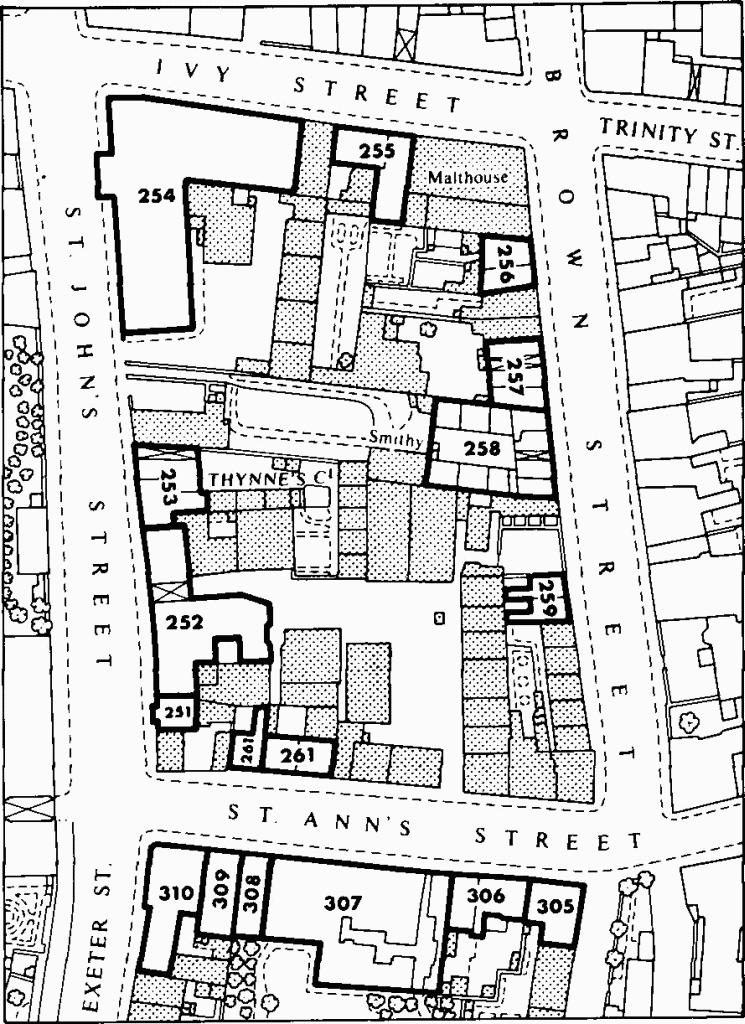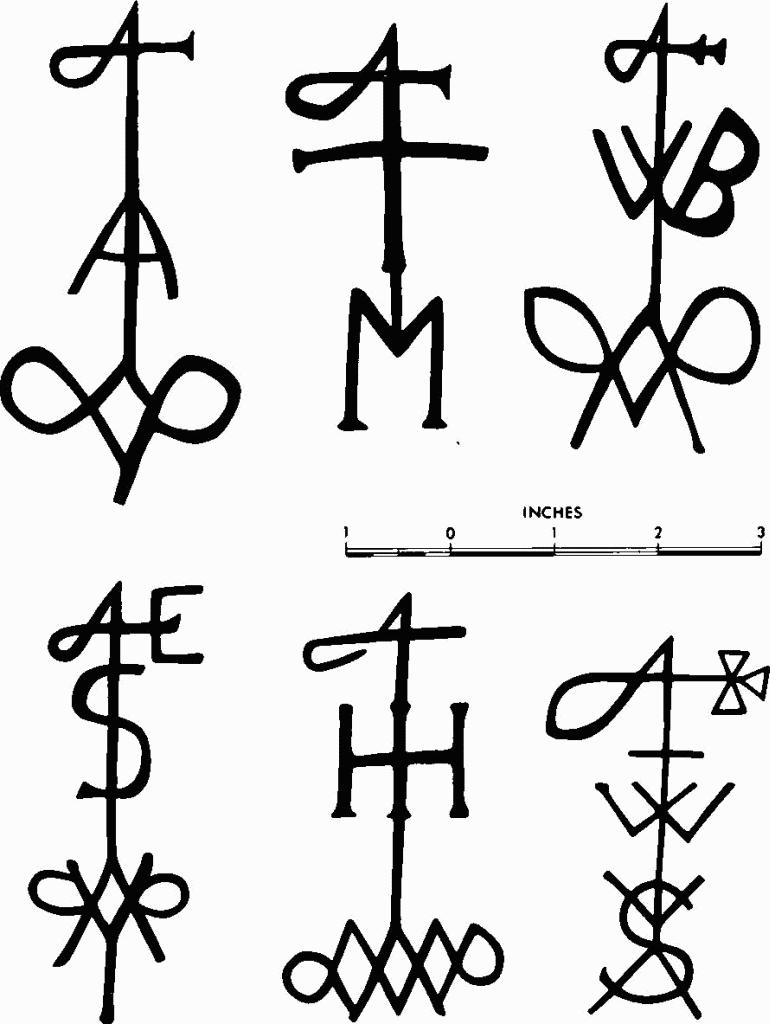Ancient and Historical Monuments in the City of Salisbury. Originally published by Her Majesty's Stationery Office, London, 1977.
This free content was digitised by double rekeying. All rights reserved.
'White Hart Chequer', in Ancient and Historical Monuments in the City of Salisbury(London, 1977), British History Online https://prod.british-history.ac.uk/rchme/salisbury/pp116-119 [accessed 1 February 2025].
'White Hart Chequer', in Ancient and Historical Monuments in the City of Salisbury(London, 1977), British History Online, accessed February 1, 2025, https://prod.british-history.ac.uk/rchme/salisbury/pp116-119.
"White Hart Chequer". Ancient and Historical Monuments in the City of Salisbury. (London, 1977), British History Online. Web. 1 February 2025. https://prod.british-history.ac.uk/rchme/salisbury/pp116-119.
White Hart Chequer
(251) House and Shop, No. 13 St. John's Street, of two storeys with ashlar walls and a slate-covered roof, was built c. 1820 as the atelier of William Osmond, statuary and monumental mason. The elegant W. facade in the grecian style has Doric columns flanking the central doorway, and an entablature with triglyphs. The upper storey has a three-light sashed window.

Monuments in White Hart Chequer and St. Ann's Street.
(252) King's Arms Hotel, of two and three storeys with attics, has timber-framed walls and tiled roofs. A two-bay range on the W. of the court appears to be of the late 16th century. The N. range is of the first half of the 17th century and possibly corresponds with a 'newly erected house .... heretofore seven tenements commonly called the Seven Deadly Sins' leased by the Dean and Chapter in 1638 to William Symonds. (fn. 1) In 1649 the house was leased to Sir Giles Mompesson and occupied by Henry Hewett. (fn. 2) North of the N. range, a large 19th-century first-floor dining room with three windows overlooking St. John's Street is now divided up and partly in separate occupation. The low ground-floor shops under the former dining room are likely to be of earlier date and may be integral with the adjoining building (253), but only one chamfered post and a bracket are visible. In Plate 66 the jettied and gabled W. end of the 17th-century N. range is seen between the N. gable of the 16th-century range and the S. end of the dining room.
Inside, the buildings have been extensively remodelled, but timber framework remains exposed. The court has been roofed over in the lower storey and encroached upon by corridors on the first floor. The first-floor room at the W. end of the N. range retains a moulded stone fireplace (Plate 92) and oak panelling of c. 1638; the stone shield over the fireplace, with arms of Mayne of Teffont, quartering Barnes, Mompesson and Hele, appears to be of the 19th century. The middle room on the first floor of the N. range has a plain stone fireplace with a cambered and chamfered head on which are scratched initials and dates (the earliest decipherable 1651) and six merchant marks as illustrated. In the third storey of the N. range, the W. chamber has a stone fireplace-surround with a moulded four-centred head and jambs with shaped stops. The staircase is mainly of the 18th century, but the top flight retains a stout 17th-century balustrade. A 17th-century stone fireplace at the S. end of the dining room shows that there was an earlier room in this position.


Merchant marks in King's Arms Hotel.
(253) Houses, now shops, Nos. 3 and 5 St. John's Street, are two-storeyed with attics and have timber-framed walls and tiled roofs. The three-bay W. range, with exposed timber framework jettied on the first floor, is of the 15th century. Adjacent on the E. of No. 3 is an early 17th-century two-storeyed timber-framed addition comprising one room on each floor and a spiral staircase. The lower room has an original window with ovolo-moulded oak mullions. The upper room, lined with 17th-century oak panelling, has a stone fireplace with a moulded four-centred head and continuous jambs with shaped stops. The 16th-century roof has collared tie-beam trusses with clasped purlins.
(254) White Hart Hotel, at the N.W. corner of the chequer, of three storeys with brick walls and slate-covered roofs (Plate 81), appears to be mainly of c. 1820 although an inn of this name existed on the site in 1635. (fn. 3) The W. front has a handsome Ionic portico. A two-storeyed E. extension of the N. range contains a large first-floor assembly room of c. 1840, now divided into bedrooms.
(255) Houses, two adjacent, Nos. 2–4 Ivy Street, of two storeys with rendered timber-framed walls and tiled roofs, date from the 16th century. The first floor is jettied on the north. No. 4 has an 18th-century S. extension.
(256) Houses, pair, Nos. 82–4 Brown Street, are two-storeyed with attics and have brick walls and tiled roofs. They were built during the second half of the 18th century, originally as one house, with an E. front of four bays, with plain sashed windows in each storey and with a dentilled eaves cornice. The gauged brick lintel of the original N. ground-floor window is seen above the doorway of No. 82.
(257) Houses, two adjoining, Nos. 90–2 Brown Street, are two-storeyed with attics and have rendered and tile-hung walls and tiled roofs. Of the early 18th century, the two dwellings seem originally to have been one, but it also appears that the range was at one time divided into three parts.
(258) The Barracks, a stone-fronted two-storeyed 15th-century house, almost entirely demolished during the second half of the 19th century, is represented by part of its S. wall. Drawings by John Buckler, c. 1808, (fn. 4) and by William Twopeny (Plate 9), 1833, show an E. front of some pretension. Interior views of two rooms published by Benson & Hatcher in 1843 (opp. p. 602) are based on drawings by William Capon, 1819, now in Salisbury Museum (Edwards collection); notes on the drawings prove that the rooms occupied the middle of the E. range, one on each floor. Kingdon & Shearm's map of 1854, here reproduced, shows the E. range with its projecting buttresses and, to W., a courtyard with N. and S. ranges. By 1880 (O.S.) the E. range had been replaced by four two-storeyed cottages. When the 15th-century range was demolished an ornate chimneypiece from the lower room was moved to No. 91 Crane Street (102); later it was taken to America.

The surviving S. wall of the S. range (now the boundary of a car-park) is of rubble and flint with ashlar dressings. It contains a stone window of two square-headed lights with chamfered surrounds and another window of three lights with ovolo mouldings; both are blocked.
To W. of the house, a garden originally extended across the chequer as far as St. John's Street. Adjoining properties to S. belonged either to the city or to the cathedral, and deeds record the names of many owners of the Barracks tenement. In 1431, when the house must have been quite new, it belonged to William Alessaundre, one of the city's five legal officers. (fn. 5) Later owners are recorded by Benson & Hatcher. (fn. 6) In 1649 the owner was Sir Gabriel Dowse. (fn. 7)
(259) Cottages, pair, Nos. 104–6 Brown Street, are two-storeyed with brick walls and slate-covered roofs and were built c. 1850. Adjacent to S., O.S. 1880 shows a row of five small buildings beside the street, extending to within 30 ft. of the street corner. Demolished early in the present century these five cottages were city property, (fn. 8) remaining from a much larger property (the whole S.E. quarter of the chequer) which had been bequeathed to the city in 1416 by William Ashleigh, chaplain, and acquired by royal licence in 1431. Deeds of c. 1290 show that the property comprised shops, cottages and a gateway facing Brown Street, a house on the corner and, to W., another house, the principal dwelling of the tenement. (fn. 9) The ground further W. belonged to the church. Throughout the first half of the 14th century Ashleigh's properties had been owned first by the Baudrey family, then by William le Frend (d. 1361), and from 1366 by Wm. Ashleigh sen. (fn. 10) Descriptions occur in 16th-century deeds and in the city survey of 1618. In an area called Storehouse Yard, N. and W. of the buildings, the boundary between city and church lands was ill-defined, but the yard was usually held by the innkeeper of the King's Arms Inn (252), a property of the Dean and Chapter. In 1649 the yard was sold to Edmond Edmonds, linendraper, who in 1663 also obtained the lease of the inn. (fn. 11)
(260) Houses, pair, Nos. 5 and 3 St. Ann's Street, now united, are two-storeyed with attics and have timber-framed walls and tiled roofs; they are of the 16th century. The first-floor jetty in the S. front was under-built in the 19th century. The N. elevation of No. 3 retains, at the W. end, an original flint and tile chimneybreast with ashlar dressings, a moulded stone plinth and weathered offsets. Inside, the fireplace has moulded stone jambs; beside it on the W. is a chamfered loop with a two-centred head. A first-floor partition in No. 5 has planks with moulded muntins, perhaps of the 17th century. The roofs have collared tie-beam trusses with queen-struts, butt-purlins and curved windbracing. In 1649 the tenement was occupied by Robert Smith, baker (Parl. Svy., Foy 83 (Sar. 12), f. 18).
(261) House, No. 1 St. Ann's Street, two-storeyed with an attic, with brick walls and tiled roofs, is of the 18th century.
